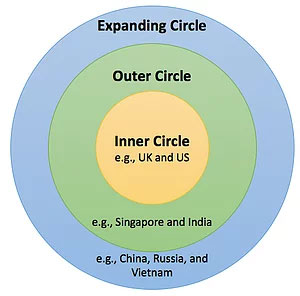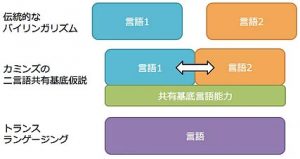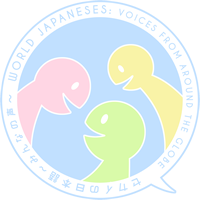Background
Background to the Project
In recent years, Japanese society has become more aware of linguistic and cultural diversity, influenced partly by the Olympics and the increase in immigration. This is true not only in Japan, but around the world as well. The increasing mobility of people demands of us an understanding of diverse people and language practices and their application to education.
This page introduces the discussion behind this project as a possible new framework for conceptualizing “language” and “speakers” in the field of English and Japanese language education.
World Englishes
The global expansion of English use has led to a growing awareness of the diversity of the English language and the need for greater discussion of the impacts of English on a variety of issues. Three major frameworks have emerged from this trend: World Englishes, English as an International Language, and English as a Lingua Franca. This section presents the most central and widely discussed of these, World Englishes.
As its plural form indicates, World Englishes points out that there is no single language called English, and that there is diversity even within the languages considered “English. Within the framework of World Englishes, Kachru (1983) focused on the relationship between former sovereigns and former colonies and presented the Circles of English consisting of an inner circle, an outer circle, and an expanding circle (see Figure 1).

Figure 1: Circles of English(Adapted from Crystal, 1995)
World Englishes describes and analyzes varieties of English, especially in the outer circle countries (former colonies) such as India and Singapore. It then argues that each of those varieties of English should be considered legitimate English, just like Englishes of the inner circle (former sovereign) that are generally regarded as the standard, since all of them function as a common language in their respective communities. The discussion of World Englishes has focused on the various inequalities that exist between speakers of different linguistic varieties, along with the frameworks of “English as an International Language” and “English as Lingua Franca.” It also provides an opportunity to critically reexamine the views of language and language teaching that are based on norms such as native speakers and standardized language.
〈Refereces〉
- Crystal, D. (1995). The Cambridge encyclopedia of the English language. Cambridge University Press.
- Kachru, B. B. (1985). Standards, codification and sociolinguistic realism: The English language in the Outer Circle. In R. Quirk and H. G. Widdowson (eds.), English in the world: Teaching and learning the language and literatures, 1-30. Cambridge University Press.
Translanguaging
Individual cognitive capacity has been described as a container, and bilinguals and multilinguals who speak more than one language with the same capacity as a monolingual speaker have been portrayed as cognitively inferior. In recent years, however, the concept of “translanguaging” (García and Li, 2014) has become prominent in the field of applied linguistics. Translanguaging considers the linguistic competence of multilingual speakers as an inseparable whole, a linguistic repertoire or idiolect (Figure 2; García & Li, 2014), rather than divided by socially constructed language. Translanguaging considers the linguistic competence of multilingual speakers as an inseparable entity, a linguistic repertoire or idiolect (Figure 2; García & Li, 2014), rather than dividing it into separate socially constructed languages.

Figure 2: Differences between traditional bilingualism and translanguaging (Adapted from García and Li,2014)
For example, when communicating, multilingual speakers do not rely on a specific language to communicate, but rather utilize their “language” in totality depending on the situation. In other words, multilingual speakers do not distinguish among individual languages in their internal world and communicate to the best of their own linguistic resources (García and Li Wei, 2014). Thus, language mixing, which has often been perceived negatively, can be viewed positively as an effective, natural, and creative way for multilingual speakers to communicate, rather than as a problem caused by inadequate or inability to use each language separately. As such, translanguaging actively values the linguistic competence of multilingual speakers and encourages diverse communication through the use of “language”.
〈References〉
- García, O., & Li, W. (2014). Translanguaging: Language, Bilingualism and Education. New York: Palgrave Macmillan.
- Otheguy, R., García, O., & Reid, W. (2015). Clarifying translanguaging and deconstructing named languages: A perspective from linguistics. Applied Linguistics Review, 6(3), 281–307.
Yasashii Nihongo (Plain Japanese / Easy Japanese)
In the field of Japanese language education, the diversity of the Japanese language in relation to non-native speakers has come to be discussed rather than the varieties and diversity within the Japanese language spoken as a first language, such as regional differences and gender differences. One such example is “Yasashii Nihongo” (plain Japanese / easy Japanese). Yasashii Nihongo” was originally developed based on the experiences of the Great Hanshin-Awaji Earthquake as a language that can be used for foreigners living in Japan in times of disaster. Currently, the discussion is not only in the context of disasters, but also in a broader scope, such as Japanese language education and accommodating foreigners.
Regarding Yasashii Nihongo in a broad sense, Iori (2013, 2019) describes the following three characteristics from the perspective of language rights of foreigners and other minorities living in the local communities.
- Form of linguistic support
- Common language in local communities
- Beginner level of Japanese for foreigners in local communities
He pointed out that Yasashii Nihongo, not English or ordinary Japanese, is a realistic option when considering communication in communities where language and culture are becoming increasingly diverse. He then pointed out the need to raise awareness on the side of the majority using the word “mind (consideration)” and suggested grammatical matters that should be addressed for that purpose.
When considering the acceptance of foreign residents into the local communities, the concept of “Yasashii Nihongo” is useful in terms of raising awareness of communication and information dissemination methods and facilitating inclusion through practical discussions. In recent years, there has been a growing awareness not only of “Yasashii Nihongo” itself, but also of the people who need it.
〈References〉
- 庵功雄・イヨンスク・森篤嗣(編)(2013)『「やさしい日本語」は何を目指すか―多文化共生社会を実現するために』ココ出版
- 庵功雄・岩田一成・佐藤琢三・栁田直美(編)(2019)『〈やさしい日本語〉と多文化共生』ココ出版
